Pharmacist Reports Two Cases of Hospital Medication Mistakes
 A hospital pharmacist has reported two incidents of hospital medication errors in which oral medications were administered intravenously.
A hospital pharmacist has reported two incidents of hospital medication errors in which oral medications were administered intravenously.
In the first case, an oral dose of LORazepam was to be administered to a 49-year old patient following surgery. The nurse removed the oral syringe from its packaging, misinterpreting the label to indicate that the drug was meant to be given intravenously. The words “oral” and “orally” appeared on one side of the label, but the nurse saw only the “C-IV” component (meaning controlled substance schedule IV) that appeared on the other side.
In a second case, a patient was to receive chlorhexidine mouthwash 4 times a day after oral surgery. The nurse drew a dose of mouthwash for the patient to self-administer; however, she used a parenteral syringe because oral syringes were not available and did not label the syringe. Returning later, she administered the contents of the parenteral syringe through the patients IV port.
While previous examples of such incidents have resulted in serious patient harm (involving sepsis, emboli, or diffuse intravascular coagulation), the incidents in question necessitated extra hospitalization and entailed no known long-term side effects.
Contributing factors in hospital medication errors
An analysis of the incidents by the Institute of Safe Medication Practices (ISMP) turned up several factors that contributed to the medication errors, including the preparation of oral medications in parenteral syringes, syringes that are unlabeled, and mental distractions while medical professionals are busy or engaged in multitasking.
The ISMP suggests the following safe practice recommendations:
- Reassess if something seems off (such as a syringe that won’t fit in an IV port); ask for additional input from another staff member who can assess the situation with a fresh pair of eyes.
- Reduce distractions. Make sure all supplies and documents are available before preparing or administering medications. Ask for help. Avoid interruptions during the most complex facets of the medication process.
- Make sure all syringes are labeled. Interruptions can lead to syringes being put down temporarily and misinterpreted and misused before medication is administered.
- Keep oral syringes on hand and use them.
- Make sure that labels are designed to avoid misinterpretation.
- Administer medications immediately after scanning so that hospital medication mistakes do not occur.
Oral/IV hospital medication mistakes
The ISMP analysis also notes that these particular incidents would not have been prevented, even if new ENFit enteral connectors had been in use. The ENFit connectors are designed to reduce the risk of tubing misconnections in a medical setting. However, the medication mistakes that occurred in these cases were not related to errors committed in connection to such devices.
The analysis states that “These cases reflect the impact of system vulnerabilities, at-risk behaviors, human factors, and technology limitations.” In both cases, the nurses were extremely distracted by multiple tasks that required their attention. In the first case, at least, the nurse had several years of experience and still made errors. While no set of recommendations will completely eliminate errors due to doctor negligence, the recommendations suggested above could reduce the frequency of errors that could lead to severe injury or death. Such instances may give rise to a medical malpractice lawsuit.
- ISMP, A Successful ENFit Launch Still Won’t Stop All Incidents of Oral Medications Given Intravenously http://www.ismp.org/newsletters/acutecare/showarticle.aspx?id=115
- Medline, ENFit Enteral Feeding Connectors http://www.medline.com/pages/enfit

 Resources
Resources
 Resources
Resources
